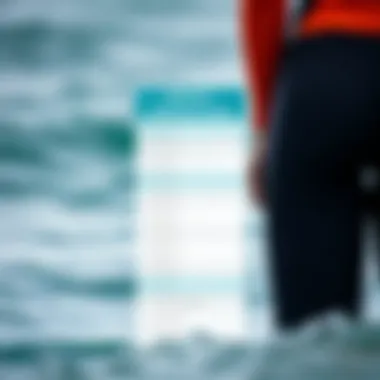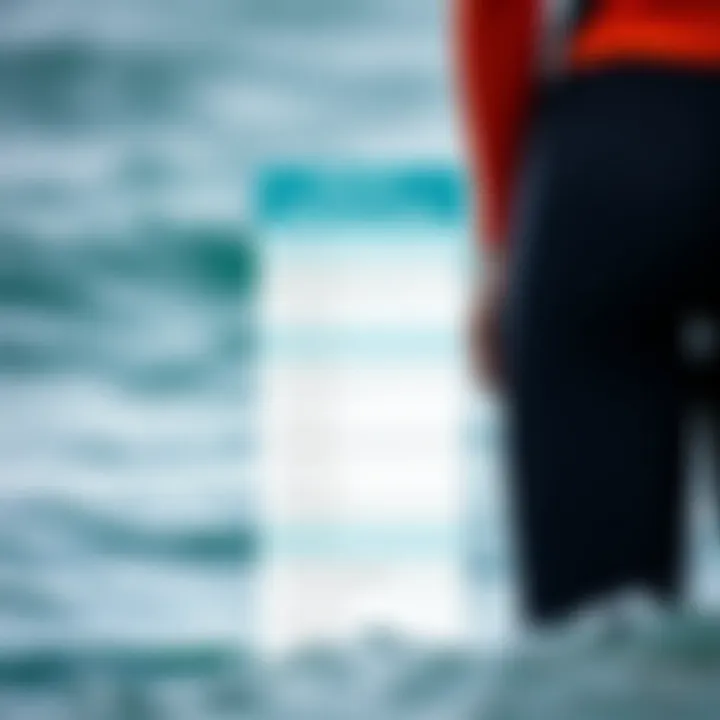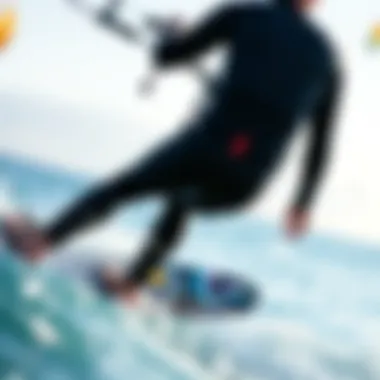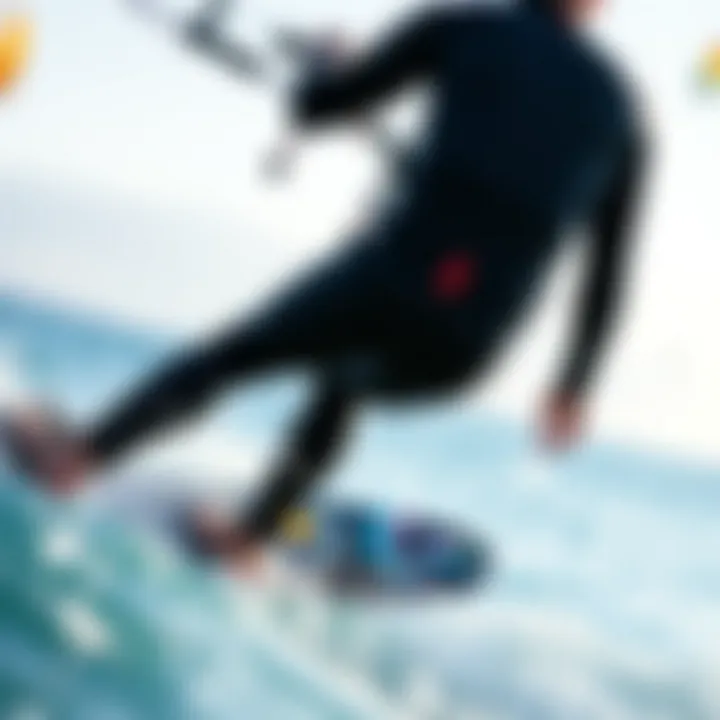Water Temperature and Wetsuit Thickness for Kiteboarding


Intro
When it comes to kiteboarding, one might think that the sheer thrill of gliding over waves is all that matters. However, the relationship between water temperature and wetsuit thickness plays a pivotal role in your overall experience. Whether you're a seasoned pro or just getting your feet wet in the sport, understanding this correlation is everything. It’s not just about comfort; it’s about performance, safety, and enjoyment.
The water can be a chilly mistress, and depending where and when you're riding, it could feel like a refreshing breeze or a freezing plunge. Different temperatures demand different gear. Choosing the right wetsuit isn’t merely about looking good on the board—it's a critical factor that can enhance your time on the water while keeping you safe from hypothermia or overheating. Knowing how to adapt your gear to the conditions can make or break your session.
This guide aims to unpack the layers of wetsuits, materials, thickness, and how they interact with water temperature. We will delve into specific gear options that suit your needs as you venture out onto the waves. You’ll find advice tailored for both newcomers and experienced riders, offering a plethora of insights to guarantee your comfort and safety while kiteboarding.
Let's dive into the specifics of Gear and Equipment, and discover how to equip yourself properly for an enjoyable kitesurfing experience.
Prolusion to Wetsuits
When it comes to kiteboarding, understanding wetsuits is fundamental. They aren't just a piece of gear; they represent a crucial link between the kiteboarder and the water. A wetsuit serves to mitigate the chilling effects of water while enhancing comfort and performance. It's essential for enthusiasts to grasp how this garment operates and how it corresponds to varying water temperatures.
Purpose of Wetsuits
Wetsuits primarily serve to maintain body heat during water activities by trapping a thin layer of water between the suit and the skin. This layer warms up due to body heat, providing insulation while maintaining flexibility. Whether you’re piercing through summer winds or braving brisk autumn waves, the right wetsuit can make a significant difference.
Understanding Protection and Performance
They offer protection against UV rays, jellyfish stings, and other aquatic hazards. A well-fitted wetsuit not only keeps a kiteboarder warm but also aids in buoyancy, which is particularly beneficial during falls or when catching a breath in frigid waters.
Types of Wetsuits Used in Kiteboarding
Wetsuits come in various forms for kiteboarding, each tailored to specific conditions and preferences. When considering what to wear, kiteboarders must account for water temperature, personal comfort, and style. Here’s a closer look at the main types of suits:
Full Suits
Full suits cover the entire body, offering comprehensive protection and insulation. They're favored in colder waters or seasons when the temperature dips. A critical feature is the thickness of the neoprene, generally ranging from 3mm to 5mm. Due to the full coverage, they enhance warmth and reduce water ingress. Full suits are an advantageous choice for kiteboarders who prefer longer sessions in brisk water.
Shorty Suits
Shorty suits provide a compromise between complete freedom and protection. With short sleeves and legs, they are perfect for warm weather kiteboarding. Their main advantage is breathability, allowing for better ventilation and ease of movement while still offering some insulation. They shine during summer months when temperatures soar, but can be insufficient in colder conditions.
Spring Suits
As the name suggests, spring suits are designed for the transitional weather of spring and fall. They often feature long sleeves but short legs, providing an intermediate option. These suits typically come in 2mm to 3mm thickness. Their design allows for sufficient warmth while permitting free movement, which is useful when the weather is unpredictable.
Hybrid Suits
Hybrid suits merge features from both full and shorty suits, typically offering coverage where it’s needed most while remaining versatile. They're usually designed with varying thickness across different body areas, enabling kiteboarders to have warmth without compromising flexibility. This makes hybrid suits a popular option for those who kiteboard across diverse conditions and want a one-size-fits-all solution.
Ultimately, the right wetsuit enhances not only comfort but also safety while navigating the unpredictable waters of kiteboarding. An understanding of these options can guide enthusiasts in making informed decisions on their gear.
The Significance of Water Temperature
Understanding the significance of water temperature is paramount for kiteboarding enthusiasts who want to maximize their experience on the water. Properly gauging how different temperatures influence wetsuit choice plays a crucial role in determining comfort, safety, and performance. Water temperature can sway how you feel out there, affecting everything from your body’s heat regulation to the gear you select to ride. Knowing these nuances can turn an ordinary kiteboarding session into an extraordinary one.
Understanding Temperature Ranges
Warm Weather Conditions
In the world of kiteboarding, warm weather conditions are often a kiteboarder's utopia. Typically characterized by temperatures above 20 degrees Celsius, this range allows for the use of lighter wetsuits or even shorter options. Riders can enjoy the exhilarating feeling of water splashing against their skin without the heavy encumbrance of thick neoprene. This scenario is a sweet spot for many, particularly during summer months, when long sessions on the water can become a daily joy. However, it's crucial to remember that even in warm waters, prolonged exposure can lead to overheating, making it essential to stay hydrated and take breaks when needed.
Moderate Weather Conditions
Moderate weather conditions fall between warm and cold, usually ranging from 15 to 20 degrees Celsius. This range offers a balanced riding experience, letting enthusiasts still feel the thrill of adventure while providing just enough insulation. A 3/2mm wetsuit often suffices, delivering warmth without sacrificing maneuverability. The beauty of moderate conditions is that they draw in crowds, creating lively atmospheres at popular kiteboarding spots.
On the flip side, these conditions require keen observation. The temperature can fluctuate unexpectedly and, thus, a kiteboarder must be ready to adapt. Amidst this uncertainty lies the charm of spontaneous adventures, a hallmark of the kiteboarding lifestyle.
Cold Weather Conditions
Cold weather conditions, anything under 15 degrees Celsius, demand serious attention. Not only does temperature drop, but wind chill can turn a functional wetsuit into a crucial lifeline. Kiteboarding in such climates requires a thickness of 4/3mm or greater depending on the chill of the wind. Adopt a mindset of preparation, as even a short session can evolve into an extended outing, making thermoregulation all the more necessary. Staying warm becomes a priority, not just to enjoy the sport but to stay safe from potential hypothermia.
Adapting to cold conditions can often result in exhilarating sessions with fewer competitors on the water, allowing for a unique experience. Nonetheless, wearing the right gear becomes non-negotiable. Ensuring proper insulation through the right wetsuit thickness can convert a potentially miserable outing into a memorable adventure.


Effects of Temperature on Body and Performance
Thermoregulation
Thermoregulation is the body’s natural ability to maintain internal temperature within a narrow range. This ability is vital when kiteboarding, as both water temperature and air conditions influence performance. Cold water triggers a physiological response where the body seeks to conserve heat, which can hinder performance if the individual is unprepared. Conversely, warm conditions may lead to overheating—without proper thermal management, a kiteboarder can easily become fatigued.
Muscle Function
The temperature of water has a significant impact on muscle function. Cold waters can lead to stiffer muscles and reduced flexibility, hampering technique and performance on the kiteboard. In contrast, optimal temperatures promote muscle elasticity and responsiveness, enhancing overall effectiveness during maneuvers. Understanding muscle function relative to temperature plays an integral role in preparing for sessions and can lead to smarter, more successful riding.
Endurance Levels
Endurance levels can be profoundly affected by water temperature as well. On a hot day, surfers may find themselves short on energy sooner than expected due to the combined heat and humidity. Meanwhile, colder waters can sap endurance if a rider is not wearing the right gear. Proper knowledge of endurance related to temperature can help kiteboarders to plan their sessions better, aiming for peak performance by recognizing the nuances of body responses to varying conditions.
Evaluating Wetsuit Thickness
When it comes to enjoying kiteboarding to its fullest, understanding the thickness of your wetsuit is pivotal. A wetsuit that’s too thin might leave you shivering after just a short session while one that's too thick can be cumbersome, affecting your performance on the water. The goal of evaluating wetsuit thickness is to strike that perfect balance between warmth, flexibility, and buoyancy, ensuring comfort and safety in varying water temperatures. This section dives deep into the significance of wetsuit thickness and offers valuable insights for enthusiasts looking to maximize their time on the waves.
The Role of Thickness
Insulation Properties
Insulation is the first line of defense against the chilly embrace of water. The thicker the wetsuit, the more layers of material there are to trap body heat. Ideally, insulation properties should keep your core at a comfortable temperature without limiting movement. A popular choice among kiteboarders is a 3mm thickness for temperate waters, striking that balance between warmth and flexibility. A standout feature is its ability to maintain warmth even if the wetsuit gets a bit wet inside due to some splashes. Your body heats up the water trapped in the suit, creating a cozy microenvironment, which is a real boon for longer sessions.
On the downside, thicker suits can sometimes be restrictive, causing fatigue during extensive riding. Thus, understanding the insulation characteristics is crucial – feel the heat, but also ensure that you can still whip your board around without holding back.
Buoyancy and Hydrodynamics
Thickness also plays a significant part in buoyancy and hydrodynamics. A well-chosen wetsuit can help you float better on the water's surface, making it easier to catch those exhilarating waves. Typically, thicker neoprene types offer better buoyancy, allowing you to maintain a more natural riding posture and reducing the energy you expend while kiteboarding.
However, it’s a double-edged sword; too much thickness can mean you’ll feel like you’re wading through molasses when trying to maneuver. If you’re battling strong winds or plan to perform aerial tricks, being too buoyant or restrictive might be detrimental to your performance.
Selecting the Right Thickness
Choosing the right thickness of your wetsuit requires careful consideration of the water conditions you’ll be facing.
Guidelines for Warm Water
In warmer water, less is definitely more. Thinner wetsuits or even shorty suits of about 2mm might just do the trick. Your skin can usually handle warmer temps, yet having a thin layer helps guard against wind chill and minor abrasions. When the sun is beating down, a lightweight suit can also offer decent UV protection. Just remember, a suit that’s too thin could leave you feeling nippy after a few hours. The right thickness for warm waters means comfort both in and out of the water, making your experience all the more pleasurable.
Guidelines for Cool Water
As you transition to slightly cooler water, a 3mm to 4mm wetsuit shines. This thickness provides enough insulation while still allowing for decent movement. Wind and water chill can sneak up when you least expect it, and a proper suit ensures that those ocean breezes can't creep in too easily. The right thickness in cool water not only keeps you cozy but also extends your time on the water without the worry of hypothermia lurking nearby.
Guidelines for Cold Water
In cold waters, you’re looking at 5mm suits or thicker. The insulation properties become more crucial, as the temperature can sap your energy quickly. Here, a full suit to shield your entire body is recommended. These suits are designed to keep you warm while being as flexible as possible. With additional features like sealed seams and windproofing, these styles offer the best protection against the elements. While thicker suits can feel bulky, modern advancements have made strides in flexibility, ensuring that you can still enjoy your time on the water without feeling like a floating seal.
Understanding the nuances of wetsuit thickness matters significantly in enhancing your kiteboarding experience. Selecting the right thickness can make all the difference between a good day on the water and one filled with discomfort.
Material Types and Their Impact
Understanding the material types used in wetsuits holds paramount importance for kiteboarding enthusiasts. Different materials not only influence the warmth and comfort of the suite but also affect mobility and durability. For kiteboarding, where performance is critical, the right choice of material can mean the difference between a frustrating day on the water and a thrilling experience.
Neoprene is the most common material used in wetsuits. Its properties have made it a staple in water sports. However, not all neoprene is created equal. Variations can include differences in thickness, flexibility, and insulation quality. Additionally, wetsuit manufacturers are incorporating various enhancements to their neoprene offerings, ensuring that kiteboarders find options tailored to their specific needs.
With innovations in design and material science, we now have a better understanding of_ how these variations can contribute to overall performance and comfort. Kiteboarders should pay attention to the type of neoprene and any additional enhancements when making their choice, as even slight variations can impact the experience on the water significantly.
Neoprene Variations
Neoprene variations are essential to remember when selecting a wetsuit. Different types of neoprene can have unique characteristics that impact insulation and flexibility. For instance, a very common variation is the closed-cell neoprene. This type of neoprene traps air bubbles in the material, providing excellent insulation, which is highly beneficial in cold waters. On the flip side, open-cell neoprene offers enhanced flexibility but may not provide the same thermal protection.
The choice between these variations often comes down to the specific conditions kiteboarders expect to encounter. If one is gliding through chilly waters, choosing a thick closed-cell neprene may favor warmth over flexibility, while warmer waters might call for a more flexible suit that allows greater movement.
Additional Enhancements


Thermal Linings
Thermal linings are an additional enhancement that greatly contributes to a wetsuit's overall effectiveness. These specialized linings offer enhanced insulation and comfort, making them a popular choice among kiteboarders facing cooler conditions. A key characteristic of thermal linings is their ability to retain body heat while still allowing for moisture management. This means that while you're battling the elements, you won’t feel like a popsicle after a cooldown session.
Unique features of thermal linings can include their moisture-wicking properties, which help to pull sweat away from your body, keeping you comfortable even during more strenuous activities. However, it’s good to note that while thermal linings add a level of warmth, they can sometimes result in additional bulkiness, which may affect movement for some riders.
Sealed Seams
Sealed seams serve as yet another enhancement that significantly contributes to the overall goal of a wetsuit; to keep water out and warmth in. The primary characteristic of sealed seams is that they are designed to prevent water from entering through the seams, which is where most water can seep into your suit. This is particularly crucial for kiteboarding, where staying dry can help maintain core temperature and comfort.
What sets sealed seams apart is their ability to combine flexibility with superior water resistance. The downside? The added construction might come with a price tag that is a bit heftier than standard seams, but for enthusiasts adamant about performance, the investment can be well worth it.
Flexible Panels
Flexible panels are designed to enhance mobility while wearing a wetsuit. By incorporating neoprene variations that prioritize stretch, these panels allow kiteboarders to maneuver with greater ease. The key characteristic here is the freedom of movement they provide, which is essential when executing complex tricks or navigating strong winds.
A unique feature of flexible panels is how they seamlessly blend with thicker sections of the wetsuit, ensuring that areas requiring warmth do not compromise on mobility. While they offer a fantastic advantage in terms of performance, one must consider that some cuts may sacrifice a bit of insulation, which could be a trade-off depending on the conditions.
Choosing the right material, along with understanding the benefits and limitations of these features, creates the perfect his and hers guide to finding the wetsuit that suits each diverse kiteboarding experience.
Through this comprehensive consideration of material types and their impact, kiteboarders can confidently select the wetsuit that not only meets their specific needs but enhances their overall experience on the water.
Comfort and Fit Considerations
When kiteboarding, comfort can make or break an adventure on the water. A well-fitting wetsuit ensures that the rider can move freely, stay warm, and maintain optimal buoyancy while performing tricks or simply cruising along. Poor fit can lead to excessive water entry, resulting in discomfort and a loss of heat—factors that can diminish performance. In this section, we will delve into how finding the right fit and considering the insulation properties affects your kiteboarding experience.
Finding the Right Fit
Size Guidelines
Choosing the right size for your wetsuit is more than a simple number; it significantly impacts overall enjoyment on the water. A wetsuit should fit snugly against the body without being overly tight. The correct fit keeps the water out while allowing a thin layer of water in, which your body can warm up. The unique aspect of size guidelines is that they usually come from reputable brands or manufacturers and include a sizing chart based on height and weight.
Common issues arise with fitting due to misinterpretations of these guidelines or opting for less-than-ideal sizes based on fashion rather than functionality. A wetsuit that is too loose won’t provide the necessary insulation; while one that is too tight can restrict movement, affecting performance.
Advantages of following size guidelines include:
- Enhanced thermal protection.
- Better range of motion.
- Overall comfort.
Adjustments for Performance
Tweaking the fit of your wetsuit may be necessary for those who are serious about their kiteboarding. Adjustments for performance focus primarily on specific areas that may need extra contouring to enhance mobility, especially around the shoulders and thighs. For instance, some wetsuits come with flexible panels that allow for a greater range of motion without sacrificing fit.
A principle to note is that performance adjustments can lead to:
- Better aerodynamics, which can increase your speed.
- Improved control during tricks and turns.
- Reduced fatigue over longer sessions.
However, the downside is that adjustments might require extra time and adjustments in the purchase process, often leading to a higher investment.
Impact of Fit on Insulation
The fit of your wetsuit directly affects its insulation capabilities. A tight-seal fit minimizes water flow, preventing the cold water from penetrating the suit. When water gets trapped inside a loose wetsuit, it cools quickly, diminishing the thermal layer your body relies upon to stay warm. On the other hand, an appropriate fit retains warmth and enhances performance, allowing for longer sessions irrespective of water temperature.
In summary, the fit of your wetsuit is foundational to ensuring both comfort and thermal protection while kiteboarding. An investment in the right size and adjustments can lead to a significant improvement in your riding experience, making it essential to find a wetsuit that not only fits well but also accommodates the unique dynamics of kiteboarding.
Seasonal Variations in Wetsuit Selection
Understanding how to select the right wetsuit based on seasonal changes is vital for kiteboarding enthusiasts. The fluctuating water temperatures and weather conditions throughout the year can create a significant impact on not only your comfort but also your overall performance on the water. Choosing the appropriate wetsuit thickness and style can mean the difference between an exhilarating session or a cold, uncomfortable outing. Tailoring your gear to match the season allows for enhanced enjoyment, minimizing risks associated with temperature extremes.
Choosing for Summer Sessions
Summer kiteboarding typically occurs in warmer waters, allowing enthusiasts to be more flexible with their wetsuit choices. Here are a few points to keep in mind when selecting the right suit for the sizzling months:
- Thickness: Many kiteboarders opt for shorty suits or even no wetsuit at all when water temperatures are high, usually exceeding 75°F or 24°C. A lightweight shorty suit, typically 2mm or less, provides protection from sunburn while allowing ample mobility.
- Material: Look for materials like lightweight neoprene that can stand the test of summer’s UV rays while providing breathability.
- Fit and Comfort: A snug fit is crucial, as it prevents water from flushing in and out, resulting in a more enjoyable ride. However, ensure it's not too tight, which could restrict movement and cause discomfort over extended wear.
- Additional Features: Look for suits with strategic cutouts, short sleeves, or open backs that promote airflow, making it easier to stay cool while slicing through the waves.
"In summer, the key is to keep it minimal. Your wetsuit should help keep you protected without sacrificing too much comfort."


Preparation for Winter Kiteboarding
Venturing out for kiteboarding in winter can be a completely different ball game. As water temperatures plunge, your wetsuit selection becomes paramount for sustaining warmth and performance. Here's how to gear up:
- Wetsuit Thickness: In cooler waters, a thicker wetsuit becomes essential. Most kiteboarders will find themselves in a 4/3mm to 5/4mm full suit, designed to provide that necessary insulation against the frigid temperatures, often below 60°F or 16°C.
- Warming Features: Seek out suits with thermal linings or special materials that not only trap warmth but also wick away moisture. Having features like sealed seams can help minimize water entry, making your time on the water much more comfortable.
- Accessories: Don't forget to invest in booties, gloves, and even hoods. These additional pieces can be lifesavers, as extremities tend to lose heat quicker than the core.
- Safety Precautions: Be aware of the signs of cold exposure, such as shivering or numbness. Always have a plan for warming up after your session, and make sure to keep a dry towel and warm clothes on hand for a quick change when you’re done.
In short, adapting your wetsuit selection to the seasons ensures you're prepared for whatever nature throws your way. Whether basking in the sun during a summer session or braving the icy waters in winter, understanding temperature impacts can dramatically enhance your kiteboarding experience.
Safety Considerations
The arctic-like chills in water can be deceptive, especially for kiteboarders who often chase the thrill of waves and winds. While the excitement is hard to dampen, it’s crucial to keep safety at the forefront. Understanding the risks associated with cold water and ensuring you’re prepared can significantly enhance both your performance and your enjoyment on the water. Proper care and a sound knowledge of safety precautions are imperative for all kiteboarding enthusiasts, whether they are seasoned pros or beginners.
Understanding Hypothermia Risks
As kiteboarders take on the elements, hypothermia becomes a lurking menace. This condition occurs when body temperature drops below the normal range, usually due to excessive exposure to chilly water or wind. Unlike many other dangers in the sport, hypothermia can sneak up on you, gradually sapping your energy and cognitive abilities, making it crucial to recognize the indicators of this silent threat.
Hypothermia can set in surprisingly fast when water temperatures dive below certain thresholds. Here are some key factors to consider:
- Water temperature: Exposure to water below 70°F (21°C) significantly increases the risk, with even colder waters amplifying that danger.
- Duration of exposure: Prolonged sessions in cold water, even mildly chilly ones, can lead to severe risks.
- Wind chill: The wind can exacerbate body heat loss, meaning even theoretically safer temperatures can be dangerous in high winds.
When kiteboarding in colder climates, it is wise to keep constant tabs on these factors. Wearing the right wetsuit thickness isn’t just about comfort; it’s a crucial barrier between you and hypothermia.
"An ounce of prevention is worth a pound of cure" – especially when it comes to your health in cold water adventures.
Recognizing Signs of Cold Exposure
Continuous rides in chilly breezes can severely impact your bodily functions, making it imperative to identify the signs of cold exposure early. Some indications are subtle, while others might hit hard. Recognizing these can be the difference between an invigorating session and a perilous situation.
Here’s a checklist of common signs to be aware of:
- Shivering: This is often the first red flag; it’s your body’s natural response to generate heat.
- Numbness: A tingling sensation in the extremities like fingers and toes can signal that your body is struggling to maintain warmth.
- Fatigue: If you start feeling unusually tired, it could be a sign that your body is expending excess energy trying to stay warm.
- Discoloration of skin: Pale or blue-tinted skin, particularly at the fingertips and around the lips, should never be ignored.
- Difficulty in speaking or concentrating: If thoughts start getting fuzzy or your speech slurs, it’s time to get to safety.
Temperature is not just a number on the thermomete; it affects mental acuity and physical abilities. Prioritizing safety through awareness can save lives on the water. It’s wise to have a buddy system, where kiteboarders keep an eye on each other, particularly in less-than-ideal conditions.
For more information on how to stay safe in extreme water sports, you can check resources from the National Institute of Health or safety guidelines from American Red Cross.
Care and Maintenance of Wetsuits
Caring for and maintaining your wetsuit is just as crucial as selecting the correct thickness for the water temperature you'll face while kiteboarding. A well-kept wetsuit not only extends the life of the material but also ensures optimal performance and safety on the water. By dedicating some time to proper care, kiteboarders can preserve the insulation properties and functionality of their wetsuits, keeping them in peak condition session after session.
Proper Cleaning Techniques
Cleaning a wetsuit post-session might seem straightforward, but there are certain nuances that can enhance its lifespan. Ideally, rinse it gently with freshwater right after exiting the water. Saltwater, dirt, and sand can degrade the neoprene over time if left unattended.
- Rinse Inside and Out: Make sure to turn the wetsuit inside out to remove chlorine or salt deposits effectively. Use a gentle flow of water.
- Mild Soap: Occasionally, a mild soap specifically designed for wetsuits can be used, but avoid anything harsh or abrasive. No one likes a stinky suit, but using the wrong soap achieves the opposite.
- Avoid the Washing Machine: Seriously, do yourself a favor, don’t toss it in the wash. The agitation can ruin the fabric and seams. Plus, you wouldn't want the sudden whirl of your beloved wetsuit with your delicates, right?
- Drying: Hang it away from direct sunlight after rinsing. Direct heat can dry out the neoprene, making it brittle. A shady spot or indoor area works wonders.
Storage Best Practices
When it comes to storing your wetsuit, out of sight doesn’t have to mean out of mind. Proper storage can prevent unnecessary wear and tear, preserving its structure and fit. Consider these aspects:
- Use a Thick Hanger: Using a hanger meant for suits can maintain the wetsuit's shape better than a flimsy one. Avoid getting those unsightly shoulder bulges.
- Roll It Up: If space is tight, try rolling it instead of folding. This reduces the risk of creases, which can lead to tears.
- Avoid Heat Sources: Stay away from garages with heaters or basements with dampness, as both can wreak havoc. Wetsuits prefer to be stored in a cool, dry place.
- Check Periodically: Occasionally pull it out to check for any pests or signs of mold. A quick look can save you from diving into a potentially musty suit.
An ounce of prevention is worth a pound of cure. When you take good care of your wetsuit, you're not just preserving gear; you're ensuring your comfort and safety out on the waves.
In summary, maintaining your wetsuit through proper cleaning and thoughtful storage practices will help it serve you well for many seasons. Remember, a good wetsuit doesn’t just keep the chill away; it keeps you in the game longer.
End
The connection between water temperature and wetsuit thickness is crucial for kiteboarding enthusiasts. Understanding this relationship not only enhances performance but also ensures safety and comfort in varying conditions. Kiteboarding is a thrilling sport, but it can be unforgiving if the right gear is not selected. An ill-fitting or inappropriate wetsuit can spoil the enjoyment of a day on the water, making this topic worthy of attention.
Summary of Key Points
In this article, we discussed several important elements:
- Wetsuit Types: Full suits, shorties, spring suits, and hybrids each have specific uses depending on the temperature and conditions.
- Temperature Ranges: Water temperatures range from warm to cold, which influences wetsuit choices significantly. Understanding these ranges helps kiteboarders select the right gear.
- Thick vs. Thin: The thickness of a wetsuit is a vital factor in heat retention and buoyancy, impacting overall performance.
- Material Influence: Different neoprene materials can enhance comfort, flexibility, and warmth. Knowing which features add value is beneficial.
- Care and Maintenance: Proper care for wetsuits prolongs their life and keeps them performing at their best.
Final Thoughts on Wetsuit Selection
When choosing a wetsuit, several considerations come into play: the water temperature, individual body type, and how long you intend to stay in the water. It is suggested to try several suits to find the perfect fit, as comfort can greatly affect performance and enjoyment.
Remember, a well-fitted wetsuit not only ensures warmth but also aids in maneuverability, giving you the edge you need to ride those waves successfully!
As temperatures fluctuate and conditions change, being proactive about checking water temp and selecting the right thickness will allow kiteboarding enthusiasts to hit the water prepared, safe, and ready for an exhilarating adventure. With the right gear, every session can be a fantastic experience.















